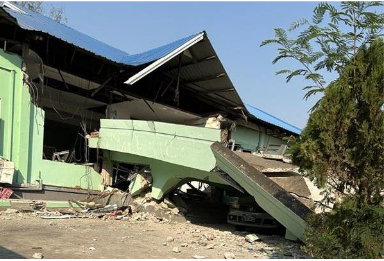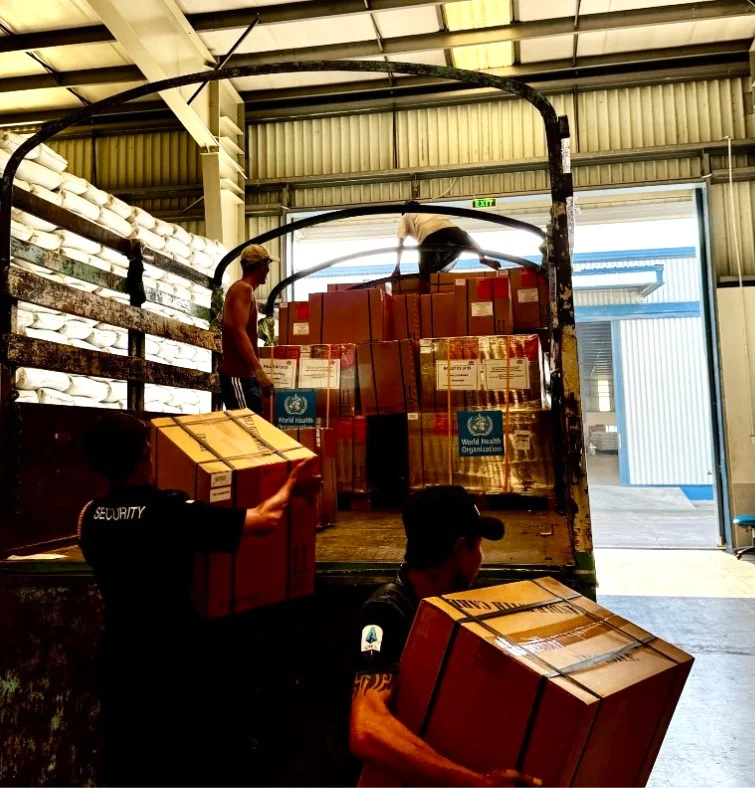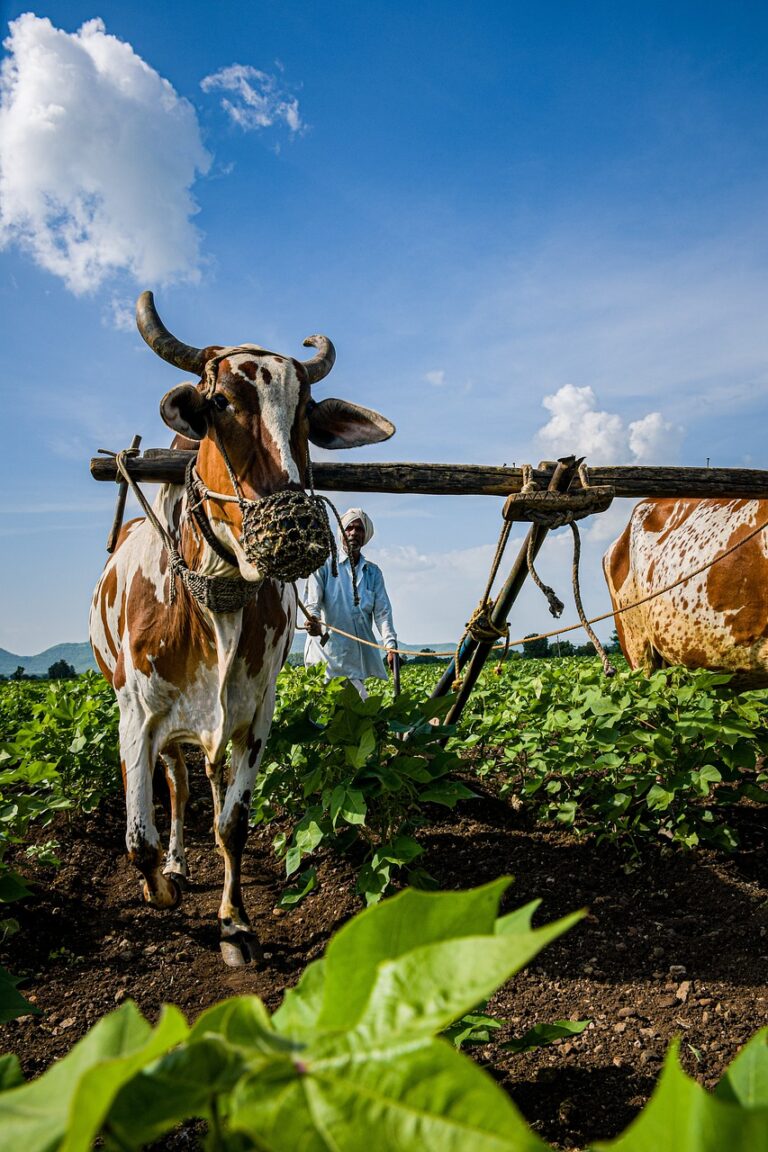
A collapsed health facility building in Nay Pyi Taw (©WHO Myanmar)
Nay Pyi Taw (Myanmar): The aftermath of the powerful March 28, 2025, earthquake in Myanmar has left thousands dead and injured, overwhelming hospitals and straining the country’s already fragile healthcare system. Rescue teams continue to battle massive destruction in heavily impacted regions: Bago, Magway, Mandalay, Sagaing, Nay Pyi Taw, and Shan South and East.
The casualties are likely to be highest in the urban areas of Mandalay, Sagaing and Nay Pyi Taw where the earthquakes caused largescale destruction of structures and buildings. As per initial reports, in Nay Pyi Taw some public and private health facilities including a large polyclinic have been damaged. Information from Sagaing is limited as electricity and communication is largely disrupted.
The latest reports from the State Administration Council (SAC) confirm 2,056 deaths and 3,900 injuries, with 3,034 deaths and 3,517 injuries reported by local media. The death toll is expected to rise as rescue operations continue, as 498 are still reported missing nationwide as of 15:00 hours local time today, including 1787 deaths in Mandalay, 405 in Nay Pyi Taw, 699 in Sagaing, 106 in Southern Shan and 35 in Bago.
“The full scale of damage, deaths and injuries has not yet been fully understood,” the World Health Organization said today.
Older buildings that have collapsed pose high asbestos exposure risk, it said today. It warned that hot weather (35○C to 40○C during the day time) and the risk of fire could exacerbate the overall critical situation. At the same time, a potential low-pressure area is expected to form in the Bay of Bengal this week, which could lead to heavy rainfall in many parts of the country. This may further challenge rescue and relief operations due to the shortage of temporary shelters.
There is concern that the dam may collapse in the affected area, potentially leading to flooding in several downstream communities and exacerbating the challenges
As of today, hospitals across the affected areas are overwhelmed, and there is an urgent need for trauma care, blood transfusion supplies, anesthetics, and essential medicines. The escalating number of casualties has stretched medical resources thin, leading to a critical shortage of healthcare services. The World Health Organization (WHO) is responding rapidly to the crisis, dispatching emergency medical kits and mobilizing international aid to support rescue efforts.

The supplies that reached the hospitals today comprised of multipurpose tents to also create space for the increasing number of injured; and trauma kits to treat severe wounds and fractures.
WHO has already delivered nearly three tons of medical supplies, including trauma kits and multipurpose tents, to hospitals in the worst hit Nay Pyi Taw and Mandalay to treat those with severe injuries. The supplies comprising of trauma kits and multipurpose tents have reached a 1000 bedded hospital in Nay Pyi Taw and is soon reaching the Mandalay General Hospital, the two main hospitals treating the injured in these areas.
These supplies were rushed from the emergency stockpile in Yangon to the earthquake-affected areas within 24 hours of two strong earthquakes of 7.7 magnitude and 6.4 magnitude hitting central Myanmar on Friday, March 28, 2025. These supplies are intended to provide immediate relief, enabling healthcare workers to manage the high number of patients and ensure that hospitals can handle the overflow. The organization is also preparing a second shipment of Inter-Agency Emergency Health Kits, which are set to arrive tomorrow. Each of these kits contains sufficient supplies to treat 10,000 people for three months, addressing the critical medical needs in the hardest-hit areas. As hospitals struggle to manage the influx of patients, WHO is providing operational support to rapid response teams deployed in the affected regions, ensuring that medical teams have the resources and logistical backing they need.
“The scale of destruction, both in terms of lives lost and the damage to health facilities, remains hard to fully assess. We are working closely with national and international partners to coordinate rapid response and provide essential care,” said Dr. Mohammad Usman, WHO Emergency Response Coordinator.
One of the most severely impacted regions is Sagaing, where communications and electricity are largely disrupted, complicating the flow of aid. Information remains limited, but local authorities report extensive damage to homes and infrastructure. In Nay Pyi Taw, a large polyclinic and several public and private health facilities have been severely damaged, hindering the ability to treat the growing number of patients. These disruptions have made it even more challenging for the healthcare system to meet the needs of the affected population, as hospitals are unable to function at full capacity. The shortage of essential medical supplies and infrastructure is exacerbating the crisis in the area.
Amidst the devastation, WHO has reached out to the global Emergency Medical Teams Network to identify teams willing to be deployed with field hospitals in Myanmar. So far, 26 international Emergency Medical Teams (EMTs) have expressed readiness to deploy field hospitals in Myanmar, working alongside local health teams to deliver medical care in areas with damaged infrastructure. These EMTs bring essential medical expertise and portable facilities that are crucial in providing care where traditional hospitals have been destroyed or are overcrowded. Their deployment will be vital to filling the gaps in the healthcare response and ensuring that survivors can receive critical care.
The humanitarian needs are expected to escalate, with a critical shortage of safe water, sanitation facilities, and mental health services. Many displaced people, having lost their homes, are sheltering in makeshift accommodations such as religious buildings, further stressing the already limited resources. With the destruction of water sources and a lack of proper sanitation, the risk of waterborne diseases is rising. The situation is further compounded by the psychological toll of the disaster. Survivors, particularly those who have lost family members or their homes, are at a heightened risk of mental health issues, including anxiety, depression, and post-traumatic stress disorder. Providing psychosocial support will be essential for both the affected population and healthcare workers, many of whom are coping with the trauma themselves.
“The challenge is not only the immediate physical needs, such as food, water, and shelter, but also the long-term psychological impact of this disaster. Mental health support will be crucial in the coming days,” said Khin Nyo, a local coordinator for a Myanmar-based NGO.
Before the earthquake, 12.9 million people in Myanmar were already in need of humanitarian health assistance due to ongoing conflicts and other crises. The earthquake has further strained the nation’s healthcare system, and many areas remain without adequate medical supplies or staff to address the scale of the emergency. The already fragile healthcare infrastructure is now facing the added burden of responding to a massive disaster, complicating efforts to deliver adequate care and humanitarian aid.
As rescue operations continue, the WHO is preparing for a rapid needs assessment to identify gaps and tailor the response for specific regions. The situation in Mandalay and Sagaing remains particularly concerning due to the extent of the infrastructure damage, and it is feared that the death toll may rise significantly as more information becomes available. As healthcare teams continue to work tirelessly on the ground, the coming days will be crucial in determining the full scale of the disaster’s impact.
The international community’s support will be essential in the coming days as Myanmar grapples with the aftermath of one of its deadliest earthquakes in recent memory.
Key Needs
There is an urgent demand for trauma care and surgical support in the affected areas as hospitals continue to be overwhelmed by the large number of injured. Medical teams are working under extreme pressure to perform surgeries and provide life-saving treatments for those with severe injuries. As casualties rise, the need for blood transfusion supplies becomes even more critical to save lives, especially as many patients require immediate blood to survive. Additionally, there is an acute shortage of anesthetics and essential medicines, which are necessary to conduct surgeries and treat both acute and chronic health conditions.
Mental health and psychosocial support are also of paramount importance in the aftermath of the disaster. The psychological toll on survivors and healthcare workers is already apparent, and mental health services will be vital to help individuals cope with the trauma of losing loved ones, homes, and livelihoods. Meanwhile, safe drinking water and sanitation remain a pressing issue, as the lack of proper infrastructure is increasing the risk of waterborne diseases. Providing clean water and hygiene services is critical to reducing the threat of further health complications.
The international community’s continued support will be essential to meet these urgent needs and assist Myanmar in its recovery, WHO said.
– global bihari bureau





